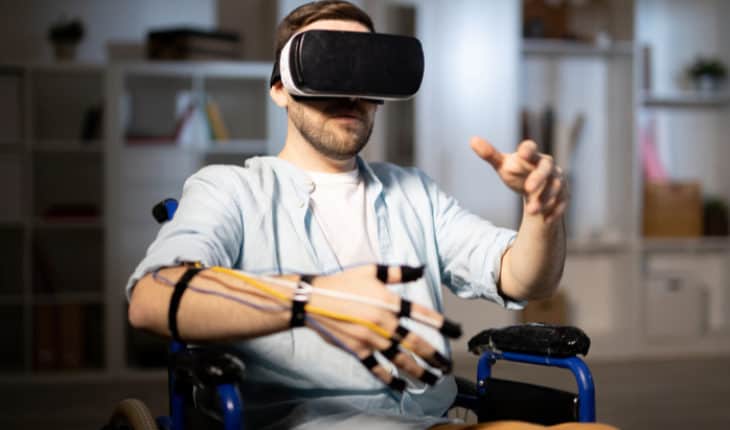VR rehabilitation: An innovative Curtin University research project that uses an interactive, home-based virtual reality (VR) simulation or ‘serious game’ to improve upper limb function in people with spinal cord injuries has been boosted by funding from the Insurance Commission.
The immersive VR rehabilitation program, which uses cooking a virtual steak as a functional rehabilitation activity for people with cervical spinal cord injuries, was developed at Curtin through a feasibility study with one participant and will now be extended to five other participants in a pilot study.
Lead researcher Associate Professor Marina Ciccarelli from Curtin’s School of Occupational Therapy, Social Work, and Speech Pathology said the technology was developed as an adjunct to conventional rehabilitation that can occur at home, which maximised opportunities for functional recovery, increased opportunity for daily rehabilitation, and minimised time, travel, and therapy costs.
“If a spinal cord injury is incomplete, there is potential to regain sensation, movement, and control through rehabilitation,” Associate Professor Marina Ciccarelli said. “Our research team will now collaborate with five people who have incomplete cervical spinal cord injuries to customise the VR-simulation to address their individual therapy needs and goals regarding specific arm movements.
“Virtual tasks include seasoning, frying, flipping and transferring a steak from pan to plate, which when done repetitively over time help improve the participant’s control and range of upper limb movements.”
Associate Professor Ciccarelli said the person’s daily progress in the VR game could be remotely measured and reviewed by their therapist, and the level of challenge adjusted as needed. “Upper limb motor function will be measured before, during and after the six-week program, which is done at home with 30-minute daily sessions and requires minimal carer support.”
Commission Secretary, Kane Blackman, said the Insurance Commission funds initiatives that seek to increase the independence of people with spinal injuries caused in a vehicle crash or at work. “The cost of lifetime care and treatment for a person with a catastrophic injury, funded by the Insurance Commission, is estimated to be $4m on average,” Mr Blackman said. “Early and effective rehabilitation can significantly enhance a person’s independence post injury. This innovative technology allows rehabilitation to occur daily in the home, minimising time, travel and therapy costs associated with attending outpatient rehabilitation.”
SpinalCure Australia, the Minderoo Foundation and Applecross Rotary supported the project by helping fund the purchase of the VR headsets.
In addition to the VR rehabilitation project, the Insurance Commission is also funding another Curtin-led research project into cognitive functional therapy, which integrates physiotherapy and psychology treatments to improve recovery of people with neck and back injuries, and personal coaching as a means to return people to work following an injury.
The research program is coordinated by the Australian Physiotherapy Association and Occupational Therapy Australia
- New lipid-based pathway discovered as key to memory formation - 25th June 2025
- Crucial link could explain how Alzheimer’s takes hold - 25th June 2025
- Understanding Your Mind Can Improve Daily Life - 25th June 2025







